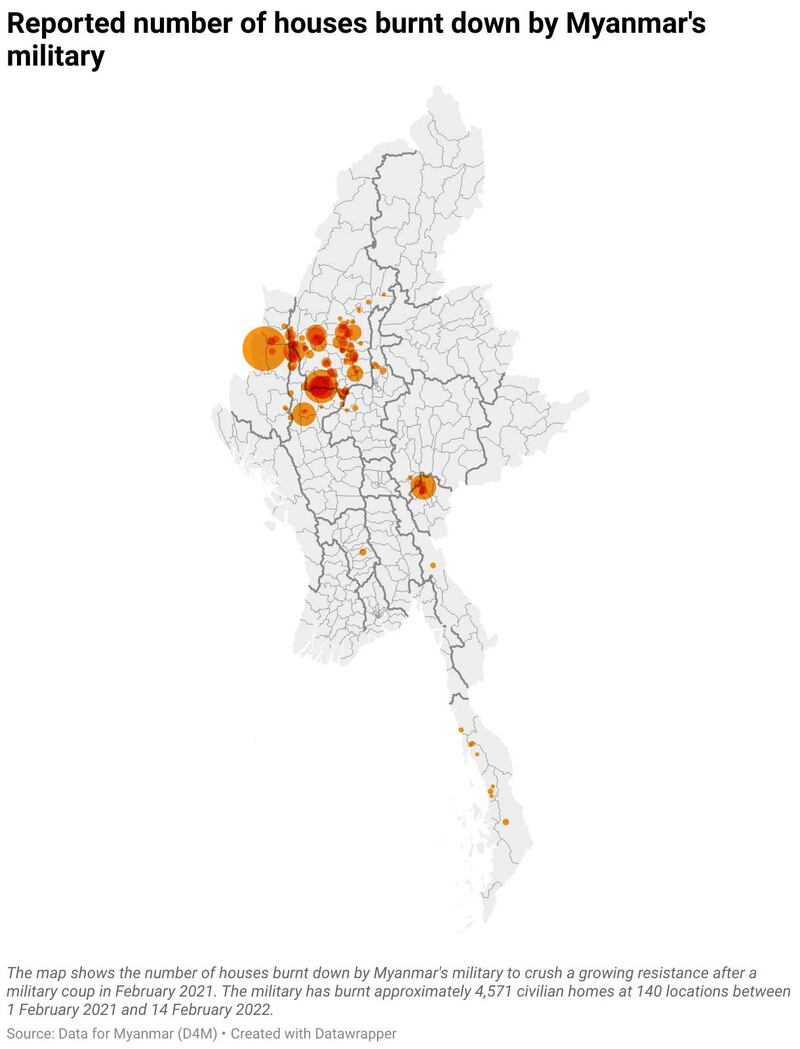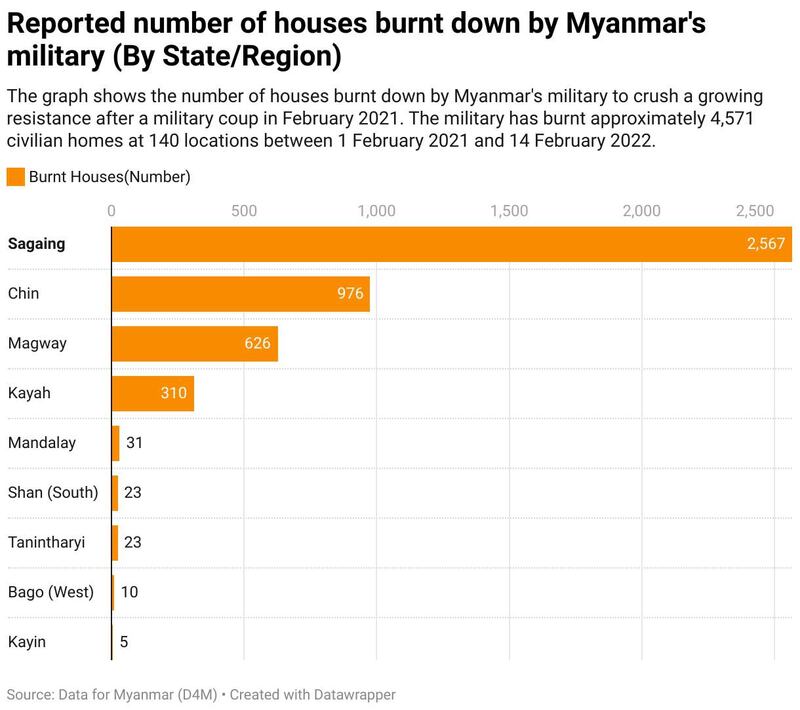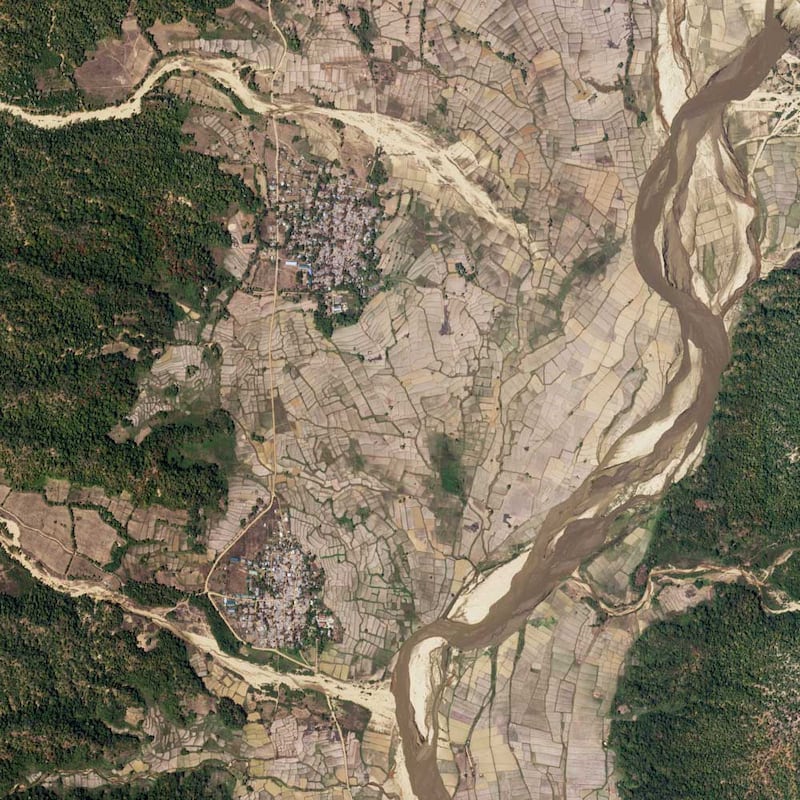Junta troops have razed at least 4,571 civilian homes since Myanmar’s military seized power in a coup just over a year ago, more than half of which were in the country’s embattled Sagaing region, according to a group that monitors the effect of political and armed conflicts in the Southeast Asian nation.
Research group Data for Myanmar said in a report that the military set 2,567 homes alight in Sagaing, 976 in Chin state, 626 in Magway region, 310 in Kayah state, and dozens of others in Mandalay region, Southern Shan state, Tanintharyi region, Bago region and Kayin state.

The homes were targeted in townships where anti-junta resistance in the form of prodemocracy People’s Defense Force militias and armed ethnic groups has been particularly fierce in recent months, and where the military response has been severe.
On Tuesday, watchdog group Fortify Rights urged the Association of Southeast Asian Nations to back a U.N. Security Council-mandated arms embargo prohibiting the sale of weapons to the junta, citing reports of military abuses in Kayah state and elsewhere that it warned could amount to war crimes.
In interviews with RFA’s Myanmar Service, sources in the country’s remote border regions have routinely described troops using civilians as human shields and committing other abuses, including arson, arbitrary arrests, torture, sexual abuse and even murder.
Data for Myanmar said that incidents of village arson began at the end of May 2021 and peaked in October, November and December in 2021, as well as February this year.

Speaking to RFA on Wednesday, a 35-year-old man from Magway’s Gangaw township detailed the hardships he and his family have faced since the military came to his village of Hnan Khar and burned down the home that had been in his family for generations.
“When I returned home [from fleeing the military raid], the house was gone. It had been turned to ashes,” he said, speaking on condition of anonymity citing fear of reprisal.
“I lost around 50 million kyats (U.S. $28,100) and all of my food supplies are gone. I am living in a small shed nearby and for meals I must eat food donated for refugees.”
The young man said the military has carried out arson attacks in Hnan Khar village at least five times since the Feb. 1, 2021, coup, leaving many residents homeless.
A woman from Sagaing’s Pale township who also declined to be named told RFA in an interview that she had lost everything she owned when her home was burned down, even her pots and pans.
“We were hiding in the woods [when the soldiers came]. The house was burned down around 1 a.m. and I discovered that it was gone the next morning,” she said.
“I am grieving over our losses, but I don’t want to be lost in despair. I try to encourage myself and others to remain active. We heard homes in other villages were burned down, so we knew this could happen to us one day.”
Blaming the PDF
Residents said junta forces appeared to be using arson as a weapon against villages they consider to be havens for members of the prodemocracy People’s Defense Force (PDF) militia, those located closest to the sites of attacks on military troops, and those marked by pro-military militia groups such as the Pyu Saw Htee.

Junta Deputy Information Minister Maj. Gen. Zaw Min Tun told RFA in recent weeks that PDF forces have been burning down homes and not the military. He has also denied the existence of the Pyu Saw Htee.
Responding to Zaw Min Tun’s comments, a member of the Taze Township PDF in Sagaing said his militia fighters have no reason to set homes on fire.
“They are trying to label PDF forces as terrorists, but it is their forces who enter the villages and burn down homes for no reason,” he said.
“They destroy property, they capture and torture villagers who cannot flee. Some of them end up dead. We PDF forces are supported by the local people. We won’t burn down the homes of our supporters in our own villages.”
Aung Thu Nyein, the director of the Institute for Strategy and Policy, a Myanmar-focused think tank, said arson plays an integral role in the military’s operations to eliminate PDF forces, and likened it to “draining water to catch fishes.”
“I think this is their tactic for collective punishment. This is part of their military strategy. Or it could be order came from low-ranking officers. I don’t know it for sure,” he said.
“In my view, it is hard to conclude that they are committing arson as part of any policy. I don’t see any evidence pointing to that. However, these are very common tactics used in counterinsurgency operations.”
Aung Thu Nyein said the losses of homes that took years to build would lead to bitter resentments among the civilians and drive them to stronger resistance.
Reported by RFA’s Myanmar Service. Translated by Ye Kaung Myint Maung. Written in English by Joshua Lipes.
